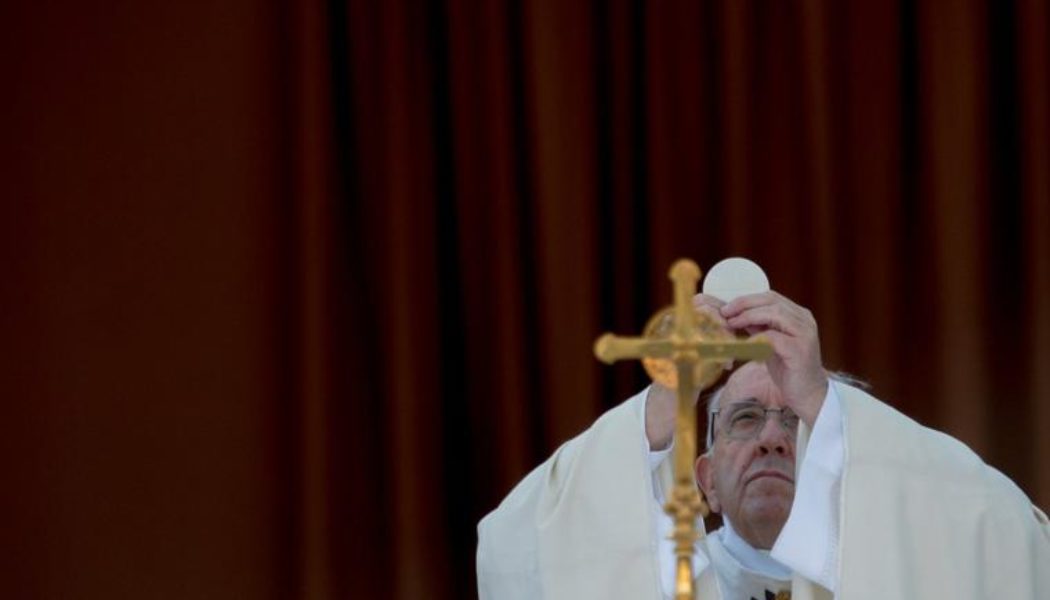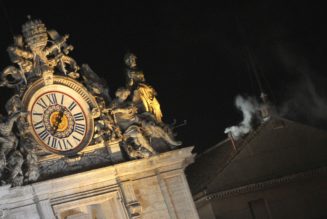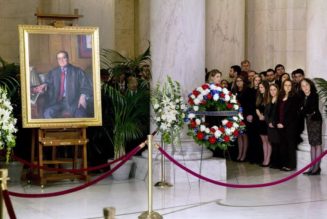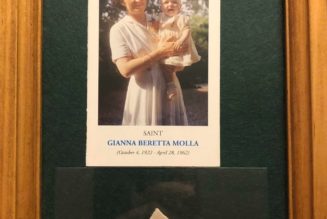
COMMENTARY: The transfer of the Vatican celebration of the feast of Corpus Christi to Sunday, instead of today, is one of the liturgical innovations that invite further explanation from the Vatican.
Thursday is the traditional day for the feast of Corpus Christi, though in much of the world it is transferred to Sunday (June 6 this year).
There is something odd going on the Vatican though this year — the latest in a series of oddities that have marked the pandemic. Strange things have been happening the world over as pastors struggle to maintain public worship in a time of closures, but six pandemic oddities invite further explanation from the Vatican.
Corpus Christi
The date for Corpus Christi is Thursday after Trinity Sunday. Many places transfer the feast to Sunday, but the Vatican City keeps the traditional date, as one would expect.
For years, Pope St. John Paul II would celebrate Corpus Christi Mass at St. John Lateran and then follow the Eucharistic procession to St. Mary Major. Both papal basilicas are extraterritorial parts of Vatican City. The traditional Thursday date was observed.
Pope Francis kept that custom until 2016. In 2017, he celebrated Corpus Christi on Sunday at St. John Lateran, which was ambiguous. As part of Vatican City it keeps Corpus Christi on Thursday, but it is the cathedral of the Diocese of Rome which, like Italy, moves Corpus Christi to Sunday.
Since 2018, the ambiguity has been resolved. Pope Francis goes to a Roman parish for Corpus Christi Sunday, and the papal procession to St. Mary Major has been set aside. (Not for any lack of affection; Pope Francis has visited St. Mary Major dozens of times, more than any other pope.)
So what happened in 2020, and will happen again in 2021?
The Holy Father will celebrate Corpus Christi in St. Peter’s due to the pandemic. But not on Thursday, but Sunday. Given the restricted numbers, it is just as easy to have the Mass on Thursday, the proper date in the Vatican, than it would be on Sunday.
Has there been a de facto shift in the feast of Corpus Christi in the Vatican? And if the traditional date is not kept in the Vatican itself, where should it be kept?
Ascension Thursday/Sunday
The same Thursday/Sunday shift often happens with the Ascension. Some dioceses in the United States keep the feast on Thursday, its biblically-fixed date 40 days after Easter; others transfer it to Sunday.
This year Pope Francis celebrated Sunday Mass for the suffering people of Myanmar in St. Peter’s on May 16. In the Vatican that would the Seventh Sunday of Easter, Ascension having been kept on Thursday.
What was done? The Office of Liturgical Celebrations, which posts notices about the pontifical ceremonies online, strangely left it off its website. The Holy See website had the homily, which was entitled “Solemnity of the Ascension — Seventh Sunday of Easter,” which does not exist. It is either one or the other. The homily itself made reference to neither. No explanation was offered.
Holy Thursday
Holy Thursday is always on Thursday, no matter where it is. It is never transferred to Sunday.
Pope Francis, from the beginning of his pontificate, has neither celebrated the Mass of the Lord’s Supper in St. Peter’s nor at St. John Lateran. He has visited prisons, hospitals and homes for the elderly instead.
In 2020, during the pandemic, his Mass of the Lord’s Supper was in St. Peter’s, including a touching tribute to priests who heroically exercise their ministry.
This year, Pope Francis went instead to the private apartment of Cardinal Angelo Becciu, leaving the public Mass of the Lord’s Supper to the dean of the college of cardinals in St. Peter’s. He instead celebrated the Mass privately with Cardinal Becciu, whom he had stripped of all cardinalatial privileges last September over allegations of financial scandal.
One of the privileges cardinals have is to celebrate the Sacred Triduum in their private households. Cardinal Becciu no longer had that privilege so perhaps Pope Francis went to do it for him. Regardless, the bishop of a diocese celebrating Holy Thursday privately is unheard of and was not explained by the papal liturgical office.
Divine Mercy Sunday
At the end of Easter Week, Pope Francis went to the nearby shrine of the Divine Mercy at the church of Santo Spirito for Divine Mercy Sunday. Nothing irregular there, but Vatican communications characterized it as a “private Mass.” It wasn’t. There was a concelebrating archbishop and priests, lectors, acolytes and a congregation. How is that “private”?
What is meant by the Holy Father celebrating a private Mass? He never does; he is always at least accompanied by at least a server. The term was never explained.
Privately Attending Mass
Can the pope privately attend Mass? In general, liturgical rules maintain that priests ought not simply sit in the pews for Mass, but should be in the sanctuary and vested. They need not concelebrate, but sit “in choir.” It is not uncommon for the Holy Father to “preside” without celebrating the Mass.
Yet simply sitting the pews is entirely unforeseen for a bishop, let alone the pope. Yet for the funeral of his personal physician in January, Pope Francis simply attended the Mass celebrated by Cardinal Pietro Parolin. No explanation for this liturgical novelty was offered by the papal liturgical office.
Papal Altar Abandoned
Perhaps the greatest mystery of the papal pandemic liturgies is the decision not to use the papal altar over the tomb of St. Peter in the Vatican basilica, even for the most solemn liturgies of Holy Week.
With only a few people in attendance, the greater height and visibility of the papal altar is not necessary; the Altar of the Chair of Peter in the basilica’s apse is sufficient. But the reason for the papal altar is not who is around it, but who is under it — the bones of the Apostle Peter himself. Even after a year has passed, no explanation for the abandonment of the papal altar has been offered.
Join Our Telegram Group : Salvation & Prosperity









